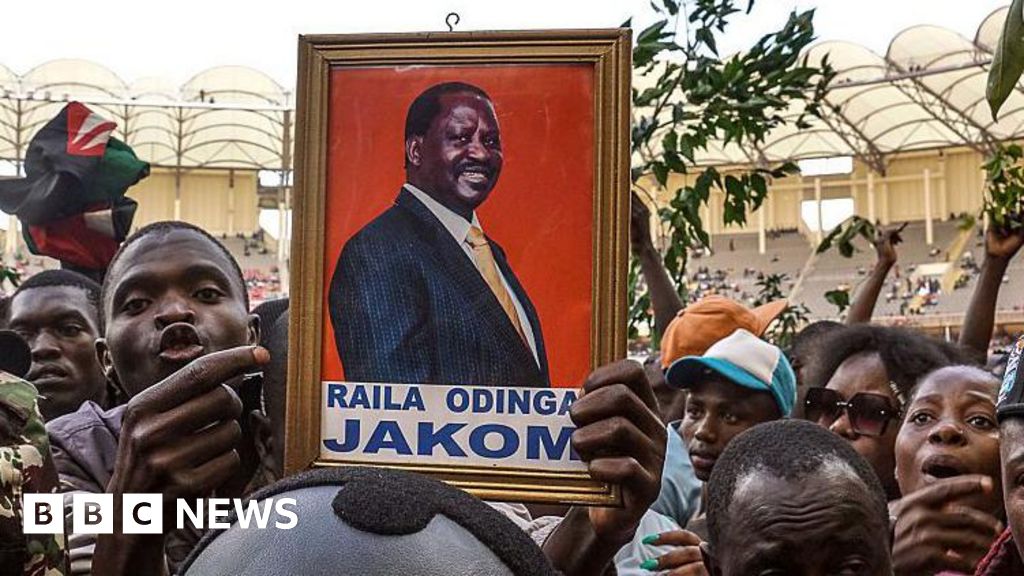As the echo of the 17-gun salute thundered through Nyamira village on Sunday evening, followed by the roar of a military fly-past, a profound silence descended across Kenya.
Amid the emotion lay the coffin of a man who never wore the ultimate political crown, yet reigned in the hearts of millions. The “people’s president”: Raila Amolo Odinga.
Odinga’s death last week at the age of 80 has shaken the nation to its core. Analysts and headline-writers have been underscoring the near-irreplaceable void he leaves – not only in politics, but in the very conscience of the country, with comparisons drawn to Nelson Mandela, who became South Africa’s first black president after white-minority rule ended.
“Raila belonged to that rare class of political personalities who transcend the ordinary calculus of power and ambition. Like Mandela, he carried the burden of a people’s hopes,” Kenyan historian Chebii Kiprono told the BBC.
From social media timelines to nightclubs, echoes of his favourite reggae song, Jamaican Farewell, continue to fill the air – a poignant reminder of the man and the movement he inspired.
Sunday’s burial was a more exclusive event – part state ceremony, part spiritual farewell, and part political reckoning for one of Africa’s most resilient political figures.
With handkerchiefs dabbing away both tears and sweat under the scorching sun, crowds cried out “Jowi! Jowi! Jowi!” – a stirring glimpse into the rich traditions and customs of the Luo people in honouring their dead.
Odinga’s ethnic group is known for its elaborate funeral rituals that include performance of a dirge. Jowi in Luo means a buffalo and the dirge signals that the deceased was a brave person with an outstanding legacy.
The very state that Odinga often challenged, and at times openly defied, came together to honour him with full military rites. It was the same state that had once imprisoned him for years without trial.
Odinga was buried by his enemies, wrote political analyst and Odinga ally Wafula Buke, in a heartfelt eulogy to the fallen leader.
“Those who threw tear gas and bullets at Raila now watch, clean… We are deleted from his last story on earth. No photos, no seats on the podium. No touch of his coffin. No space on the programme even for a poem,” added Mr Buke.
“But Raila and Mandela are, have been and will always be ours now and forever.”
According to Dr Kiprono , Odinga was “one of the last genuine revolutionaries of modern Africa”.
For years, the firebrand politician emerged as a staunch campaigner and defender of multi-party democracy and a towering figure who kept the country’s politics competitive and national discourse vibrant.
Analysts say his absence leaves a vacuum not only within the opposition, but also within President William Ruto’s government – which, like administrations before it, relied on his influence to help steady the ship amid growing public discontent.
“Without Raila, Kenya will be a radically different country. It’s entirely possible that the vacuum he leaves will create a mass movement capable of successfully demanding change,” wrote Salim Lone, a long-time confidante and spokesman for Odinga.
As his body was finally lowered into the ground, it became unmistakably clear that Kenya was witnessing the closing of an entire chapter in the story of the country’s democratic struggle.
“In his passing, our nation, our continent, and our world have lost a titan of conscience, a visionary of uncommon resolve, and defender of the defenceless whose legacy will illuminate Kenya’s democratic path for all time,” said Ruto, while eulogising Odinga.
His widow Idah said that when she got married to Odinga 52 years ago, she never knew she was marrying a political engineer.
Some, like veteran politician and former political detainee Koigi wa Wamwere, believe that Kenya could not afford to lose Odinga at such a critical moment.
“This was not the time for Raila to die. We haven’t discussed with him on whether the tactics that we’re using in fighting oppression and the problems that continue to plague the country are the best for us to apply,” Mr Wamwere said in an interview with local TV.
In the absence of a formidable national figure like Odinga and an unsteady opposition, some fear a heavy-handed state response to dissent.
“The political order Raila helped shape is being tested. The next two years will likely be filled with tumult: leadership races, coalition fracturing, emotional politics, realignments around power and identity,” lawyer Chris Omore told a local newspaper.
Odinga’s Orange Democratic Movement (ODM) party is already in turmoil, with internal factions divided over whether to support Ruto’s re-election bid in the 2027 general election.
Last year, Ruto reached out to Odinga for a political deal that saw opposition figures appointed to the cabinet – in what is now known as a “broad-based” government.
The move was seen by many as Ruto’s attempt to solidify his hold on power amid increasing discontent with his administration over its perceived failure to improve the lives of poor people, while raising taxes heavily.
Ruto has committed to ensure that ODM “will either form the government or be part of the government” in 2027.
Days before his death, Odinga had hinted at the possibility of ODM fielding its own presidential candidate in the polls.
A decision by ODM to go it alone could pose a significant challenge to Ruto, whose re-election prospects are uncertain amid rising public discontent fuelled by the cost-of-living crisis.
Last year, Ruto was forced to backtrack on plans to raise taxes after violent street protests erupted.
His popularity has also taken a significant hit following last year’s impeachment of his former deputy, Rigathi Gachagua, a key political figure from the vote-rich Mount Kenya region.
Other analysts believe that Odinga’s death presents Kenya with a chance to shift away from personality-driven politics and towards a more institutional, and inclusive democracy.
“Other younger people are going to step out to continue with Odinga’s political mission and ideological struggle,” said Barrack Muluka, a political commentator.

